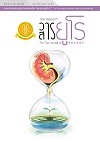Efficacy of Peritubal Local Anesthetic Infiltration in Percutaneous Nephrolithotomy
Keywords:
peritubal local anesthetic, percutaneous nephrolithotomy, ยาชาเฉพาะที่รอบแผล, การผ่าตัดนิ่วในไตด้วยวิธีส่องกล้องAbstract
Objective: To evaluate local anesthetic effect applied around the nephrostomy tract for alleviate the pain in the initial postoperative period.
Material and Methods: The single-center randomized controlled trial was conducted between November 2012 and November 2013. Fifty adult patients underwent percutaneous nephrolithotomy were randomized into two groups, a bupivacaine or study group (n=25) and a control group (n=25). After completion of a surgical procedure, 10 ml of 0.25% bupivacaine was infiltrated into the nephrostomy tract in the study group while the control group wouldn’t receive any infiltration. Primary outcome was post-operative pain which was assessed by using visual analogue scale for pain (VAS pain) at 1, 4, 12, 24 and 48 hours postoperatively. Secondary outcomes included total amount of narcotic usage in the initial postoperative 24 hours, time of the first analgesic demand and adverse effects.
Results: VAS pain score at 1 hour after the operation in the study group was significantly lower than the control group (4.6 VS 6.4, p=0.025). Total narcotic usage was 5.32 mg in the bupivacaine group and 7.02 mg in the control patients (p=0.114).The mean time for first analgesic demand was 103.48 min in bupivacaine group and 59.47 hours in control group (p=0.032). The side effects such as nausea and vomiting were non-significant in both groups.
Conclusion: The peritubal local anesthetic infiltration with 0.25% bupivacaine resulted in beneficial effects in alleviating immediate postoperative pain after percutaneous nephrolithotomy.
ผลของการใช้ยาชาเฉพาะที่บริเวณรอบแผลหลังการผ่าตัดนิ่วในไตด้วยวิธีส่องกล้อง (PCNL)
ธนฤทธิ์ จุรีมาศ, บรรณกิจ โลจนาภิวัฒน์, พฤทธ์ กิติรัตน์ตระการ
ภาควิชาศัลยศาสตร์ คณะแพทยศาสตร์ มหาวิทยาลัยเชียงใหม่
บทคัดย่อ
วัตถุประสงค์: เพื่อศึกษาผลของการใช้ยาชาเฉพาะที่บริเวณรอบแผลหลังการผ่าตัดนิ่วในไตด้วยวิธีส่องกล้อง (PCNL)
ผู้ป่วยและวิธีการศึกษา: รวบรวมข้อมูลผู้ป่วยที่เข้ารับการรักษาผ่าตัดนิ่วในไตด้วยวิธีส่องกล้อง 50 ราย ระหว่างเดือนพฤศจิกายน 2555 ถึงพฤศจิกายน 2556 โดยผู้เข้าร่วมในการศึกษาจะได้รับการสุ่มแบ่งเป็น 2 กลุ่ม กลุ่มแรกเป็นกลุ่มทดลองจำนวน 25 คน หลังจากผ่าตัดนิ่วในไตด้วยวิธีส่องกล้อง จะได้รับการฉีดยาชา 0.25% bupivacaine รอบแผลผ่าตัด ตั้งแต่ชั้นแคปซูลของไตจนถึงชั้นผิวหนัง ที่บริเวณ 6 และ 12 นาฬิกา ข้างละ 10 มิลลิลิตร ส่วนในกลุ่มควบคุม จำนวน 25 คน จะไม่ได้รับการฉีดยาชา ผลการศึกษาหลักคือ การประเมินอาการปวดหลังผ่าตัดโดย visual analogue scale for pain (VAS pain) ที่ระยะเวลา 1, 4, 12, 24 และ 48 ชั่วโมงหลังการผ่าตัด ผลการศึกษารอง ได้แก่ ปริมาณยาแก้ปวดชนิด opioids ที่ใช้ใน 24 ชั่วโมงแรก ระยะเวลาที่ขอใช้ยาแก้ปวดครั้งแรก และผลข้างเคียงของยาแก้ปวด
ผลการศึกษา: ผลการประเมินอาการปวดหลังผ่าตัดที่ 1 ชั่วโมง พบว่า กลุ่มที่ได้รับยาชามีค่าเฉลี่ยของคะแนนความปวดน้อยกว่ากลุ่มควบคุมอย่างมีนัยสำคัญทางสถิติ (4.6 และ 6.4 ตามลำดับ p=0.025) ปริมาณการใช้ยาแก้ปวดชนิด opioids ในกลุ่มที่ได้รับยาชาเท่ากับ 5.32 มิลลิกรัม เทียบกับ 7.02 มิลลิกรัมในกลุ่มควบคุม (p=0.114) ระยะเวลาในการขอยาแก้ปวดครั้งแรกใน กลุ่มที่ได้รับยาชาเท่ากับ 103.48 นาที เทียบกับ 59.47 ในกลุ่มควบคุมและมีความแตกต่างอย่างมีนัยสำคัญ (p=0.032) ผลข้างเคียงของยาแก้ปวดคือ อาการคลื่นไส้ อาเจียน ไม่มีความแตกต่างของทั้งสองกลุ่ม
สรุป: การฉีดยาชารอบแผลผ่าตัดนิ่วในไตด้วยวิธีส่องกล้องด้วย 0.25% bupivacaine พบว่ามีประโยชน์ โดยสามารถ ลดอาการปวดหลังผ่าตัดในช่วงแรกได้ดี



